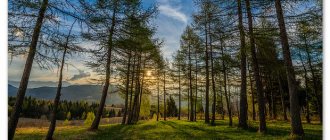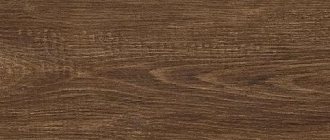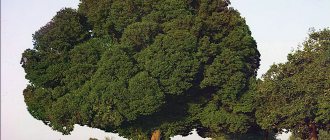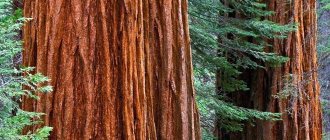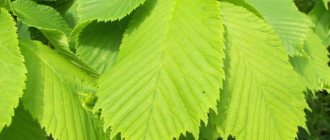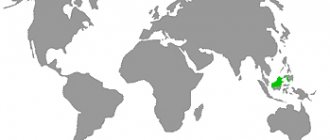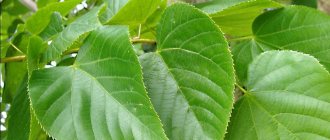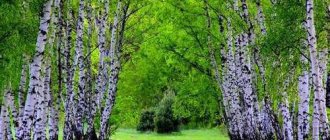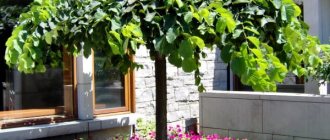Bushes and trees
0
462
Article rating
Kira Stoletova
Siberian larch (in Latin Larix Sibirica) is a coniferous gymnosperm tree belonging to the Pine family. Due to its large size in landscape design, it is mainly suitable for decorating park areas. It is rarely used for landscaping small garden plots.
Siberian larch: what the plant looks like and where it can be grown
Some general information
Siberian larch is part of the Pine family, and has all the distinctive features of the genus - it grows in the shape of a spruce or cedar, and has needles instead of leaves. Although, in fact, its needles are nothing more than leaves of a peculiar type. The transformation of leaves helped trees adapt to the sharp cooling that occurred on the planet 20-25 thousand years ago. Therefore, scientists consider conifers to be the most ancient on Earth.
But, apparently, at that moment something went wrong with the larch, and it began to shed its needles every year, differing in this feature from other members of the family.
As you know, the needles of evergreen trees are covered with a waxy coating, which contains cutin, a substance that prevents moisture evaporation and protects the needles from frost. Larch does not produce cutin, the plaque on its needles is almost invisible, as a result, the tree is forced to shed its needles every autumn.
As a rule, needles fall off the Siberian larch in October, while its closest relative, growing on the American continent, loses its needles in November.
Larch is not the only coniferous tree that gets rid of its needles in the fall. Similar behavior is observed in kaempfera (false larch), taxodium, metasequoia, and some species of the Cypress family. Seasonal shedding of needles occurs for various reasons.
As for the Siberian larch, it actually grows in the harsh climate of the Urals, Siberia, the Far East, and the European part of Russia, where nature places special demands on trees.
The tree grows together with other members of the family - spruce, pine and cedar, but sometimes forms separate forests. If you happen to visit the Siberian taiga in winter and find an entire forest of coniferous trees without needles, do not rush to sound the alarm and talk about an environmental disaster and dead trees. In spring, the trees will come to life and be covered with fresh leaves and needles.
Growing seedlings in open ground
Young coniferous trees react rather poorly to replanting, especially those with an exposed root system. Seedlings more than 2 years old should be replanted only with a large earthen lump on the roots. Speaking about planting young plants sown in special containers, it is necessary, if possible, to carefully cut the container without damaging the root system and soil around them. Such a transplant of young animals will be the most gentle.
It is necessary to propagate larch in the fall or at the very beginning of spring. During this period, the soil contains a minimum number of pathogens, which makes it possible to exclude infection of the root system.
Mycorrhiza, a form of close relationship between roots and fungi that assist the plant in the absorption of minerals, is an important individuality of the larch root system. Therefore, when propagating seedlings or mature trees, it is very important to add soil from some other coniferous plants (fir, spruce, pine) to the planting hole.
Full description of Siberian larch
Siberian larch, or Larix sibirica, is a coniferous tree belonging to the genus Larch, the Pine family (Pinaceae). The homeland of the plant, as the name suggests, is Siberia, as well as Mongolia.
The Siberian larch species differs from most coniferous trees in that it sheds its needle leaves in the winter. They are formed on two types of shoots: shortened and elongated. The first ones are 1-5 cm long and look like tubercles. Some gradually grow, others die off after 10 years.
The needles are soft, narrow-linear, light green in color. Its length varies from 1 to 5 cm, thickness - from 0.5 to 1.5 mm. On elongated shoots it is arranged spirally. On the tubercles-processes it is shorter, collected in bunches of 20-40 pieces.
The trunk narrows significantly from the root to the top and has an elongated cone-shaped shape. The trunk and large branches are covered with a thick gray-brown bark with deep cracks up to 10 cm thick. The crown has an ovoid or conical shape. The root system of Siberian larch is well developed, providing the tree with stability in strong winds.
Coniferous trees usually grow 20-40 m in height, some specimens up to 50 m. The diameter of the trunk is also impressive. In many plants it is 100-180 cm. And sometimes giants reach 1.5 - 2.5 m at the base. The crown diameter of the Siberian larch is 10-15 m.
Conifers bloom at the age of 15-20 years. Depending on climatic conditions, this occurs in April or May. At the same time, needles appear on the trees. The flowering time of Siberian larch is 1.5 weeks. Flowers are male and female. The first ones are small yellow spikelets. Most often they form on young branches. Women's are painted in a reddish color, directed strictly vertically.
Comment! Siberian larch is a self-pollinating plant. With gusts of wind, pollen rises above the trees and falls on the female cones.
The seeds ripen by the end of summer. But they do not appear every season, but at intervals of 2-3 years. In the northern regions, breaks are 6-7 years.
Siberian larch is widespread throughout almost the entire territory of Russia and is found in China, Kazakhstan and Mongolia. The tree forms pure and mixed forests over vast areas in Siberia and the Far Eastern region. Grows in mountainous areas in Altai and Tien Shan. Forms coniferous forests with Siberian cedar and spruce, Scots pine. The culture is light-loving and frost-resistant.
In the European part of Russia, wild Siberian larch is a rare plant
The tree is long-lived. Its lifespan is on average from 500 to 700 years. Sometimes there are conifers whose age is estimated at 1000 years. Siberians consider larch a symbol of ever-regenerating life, power, and longevity.
With a significant life expectancy, the plant is considered fast-growing. Within a few years, the seedling reaches a height of 100 cm or more. Then the annual growth is on average 0.5 m. And upon reaching 40 years of age, the growth rate of Siberian larch slows down. By this time, it usually reaches its maximum height and grows in width.
Comment! Trees that are 400 years old show almost no external signs of aging.
Application in landscape design
Siberian larch differs from other varieties in that it is not suitable for small areas. This is due to the intensive growth of the plant, which reaches quite large sizes. This variety is used to create compositions in parks and squares in combination with deciduous shrubs and other conifers.
The tree looks impressive as a central element of the landscape, around which flower beds of shade-loving shrubs and flowers are formed.
Economic use of Siberian larch
Larch wood is highly valued. It is hard, extremely durable, resistant to fungal diseases, and does not rot for a long time in the ground and in damp environments. A distinctive feature of larch wood is its specific gravity, close to unity. It is so heavy that when freshly cut it sinks in water, so it is floated only in rafts and bundles with logs of other tree species. And larch trunks that have lain in water for a long time harden and become even more resistant to rotting.
Larch wood is considered one of the best building materials. Logs from this tree have long been used in the construction of bridges, making strong, durable piles and decks from them. Siberians have long tried to lay the lower crowns of wooden houses from larch trunks. The tower of the Yakut fort, built in the mid-17th century from larch logs, has survived to this day. Baths made from this building material also serve people for a long time. Larch trunks are also used for telegraph poles, mine posts, and railroad sleepers. The Pomors, who lived on the coasts of the seas of the Arctic Ocean and along the rivers flowing into these seas, made the hulls of their ships from larch. Larch wood is also readily used to make furniture, plywood, and staves for kvass barrels and vats. They also make shingles from it, which are used to cover the roofs of houses, barns and other buildings. In Siberia, a lot of larch wood, especially non-commercial wood, is burned as a cheap, easily accessible fuel. The calorific value of such firewood is very high. Larch bark contains tannins, so bark extracts are excellent leather tanning agents. These tanning extracts are also used as dyes for wool and cotton fabrics, coloring the material in yellow, pink and brown tones. READ Himalayan cedar: description, varieties, planting and care
How larch is used by humans
Larch wood is an excellent building material. Due to its high density, larch wood has enormous reserves of strength and durability; even in conditions of high humidity it does not lose its characteristics.
Wood is used for low-rise construction, interior and exterior decoration. Floors and stairs are made from wood of this species, baths and saunas, swimming pools, and open terraces are built. Coniferous wood is ideal for use in buildings that will subsequently be exposed to high humidity or temperature changes.
The use of larch by humans has continued for centuries; in ancient times, the tree species was used in shipbuilding. Even with constant exposure to moisture, larch wood not only does not lose, but also enhances its strength characteristics.
Physical properties of larch: humidity, density, shrinkage and swelling
Density
The average density of larch is 650 kg/m3, but this figure may vary depending on the region of growth and the percentage of moisture in the wood. In some cases, the initial value may increase by 25-30%.
Larch wood is significantly denser than other conifers: it is 25% denser than pine, 30% denser than spruce, and 40-45% denser than fir. Siberian larch is only 7-9% inferior in this indicator to beech and oak wood. From a structural point of view, density is determined by the amount of late wood (dark zones) in relation to early wood, as we discussed in detail above.
How much does larch weigh?
1 cube of larch (12% humidity) weighs on average 650 kg.
To find out how many kilograms one larch board weighs, you first need to calculate its volume. To do this, we convert the length, width and height of the board into meters and multiply all the indicators. Next, we multiply the resulting value by 650 (average density).
For example, a larch board 25 mm thick (0.025 m), 400 mm wide (0.4 m) and 3 m long will weigh 19.5 kg.
0.03 m3 x 650 kg/m3 = 19.5 kg
Humidity
The presence of moisture in wood varies greatly depending on the area of the trunk. In less dense sapwood the moisture content is higher, in the hard core part it is much less. This is due to the anatomical specifics of the development of the trunk, as discussed above. For these same reasons, heartwood and sapwood differ greatly in their ability to transmit moisture and steam.
Shrinkage and swelling
During drying, the complex nature of larch lumber is revealed, with its tendency to warp and crack. Complex internal stresses in the wood structure can only be relieved naturally: over time, they decrease on their own, provided they are properly dried. We will talk in more detail about the technological nuances of drying larch below.
When drying larch to a working moisture content of 12%, wood shrinkage can reach up to 9-10% of the original volume. Shrinkage occurs most strongly in the tangential direction, in the radial direction it is noticeably less, and is almost imperceptible along the fibers. After drying, larch is not prone to swelling during normal fluctuations in humidity; this occurs only within the limits of hygroscopicity, when the fibers are completely saturated with moisture.
Types and varieties of larch
The classification of larches is a subject of controversy and difficulty among botanists. Adding to the confusion is the natural occurrence of hybrids. There is a saying among botanists: “Go to the forest to pick mushrooms and discover 3 new species of larch.” But those that are used in landscape design or bred artificially are well known and studied.
We also recommend reading:
European larch (common)
Widely distributed throughout Europe. But the main growing area is in mountainous areas, because the species does not tolerate swampy soils and prefers rocky soil.
The tree grows to a height of 25-40 m and has showy, slightly sagging branches. The shape of the crown can be either irregular or resemble an oval. The bark of young specimens is gray, becoming brown with age.
European larch is the ancestor of most decorative varieties, for example:
- "Repens" (Repens - "creeping"). This is a small tree, the height of which does not exceed 150 cm. It has beautiful creeping shoots.
- "Kornik" is a dwarf tree approximately 120 cm high.
- European red larch with original red cones.
In total, there are several dozen species used for landscape design.
European larch (common)
Japanese larch
Grows on dry and sunny mountain slopes. A pyramidal crown with a wide base is formed from long branches arranged in a horizontal position. The long needles (up to 5 cm) are green in summer with a slight blue tint, and turn yellow later than the others in autumn. Therefore, the Japanese variety looks most impressive in group plantings, becoming a bright spot against the backdrop of a fading garden.
Western larch
The natural habitat of this species is North America. Unlike other brethren who love light, it does well in the shade, but does not tolerate a lack of moisture in the soil. This is a very tall species: the record is 80 m, although the vast majority of larches grow more than 50 m.
Japanese larch
Siberian larch
The tree grows not only in Siberia: it is found in Altai, China and Mongolia. The species is distinguished by enviable frost resistance and the ability to withstand short-term droughts. Even dropping the air temperature to -40 °C will not cause harm. The only requirement is enough sun.
Kamchatka larch
This species grows in Kamchatka, Sakhalin and the Kuril Islands. The height of the tree can reach 35 m. The crown, as a rule, has the shape of an irregular oval. The peculiarity of the plant is its long branches located parallel to the ground.
Kamchatka larch
Maritime larch
An artificial hybrid obtained by crossing the Kamchatka variety with Gmelin larch. Its height is relatively small - up to 25 m. The branches with gray bark have sparse dark green needles with bluish tips. The length of the needles is about 3.5 cm.
Arkhangelsk larch
Arkhangelsk larch, growing up to 40 m, is similar to Siberian larch. It is distinguished by the thickening of the trunk near the ground and the light yellow color of the branches that rise upward. The needles are also collected in bunches. It grows wild in the north of the European part of Russia, in the Ural region and in western Siberia.
Mechanical properties of larch: strength, hardness, elasticity
Larch wood has high strength. In terms of compression/tension along the fibers, it exceeds pine by an average of 40%; in the direction across the grain, these indicators are noticeably lower and in some cases even inferior to pine. Compression/tension resistance is highly dependent on humidity (dry wood is stronger). In terms of resistance to mechanical damage, larch is comparable to oak. At the same time, when we talk about extraordinary strength, it is important not to forget about the mass, which exceeds the same pine by 30-38%.
Larch has a very high modulus of elasticity. In this indicator, it significantly surpasses not only all coniferous species, but also most deciduous trees. Due to this, the wood has excellent resistance to bending (including impact bending), but at the same time it is vulnerable to splitting.
Long-lived in the northern hemisphere
And now we will talk about the berry yew, a long-lived tree, since its age reaches 4 thousand years. Previously, it was common in Western Europe, Asia Minor, and the Caucasus. But people quickly destroyed this unique tree. Its wood is practically eternal and has antibacterial properties.
Houses that only had yew ceiling beams could be saved from pandemics, as the wonderful wood prevents the growth of bacteria even in the air.
Structure of larch wood
Core
Larches are heartwood species. The formation of this physiologically inactive zone of the trunk begins at 4-5 years of age. In the trunk of a mature tree, the proportion of the kernel is 70-75%. The color of the core zone is reddish-brown. It is characterized by increased hardness, biostability, and a high content of gum and resins.
Sapwood
The layer of light sapwood is thin; at the cut of the trunk it does not exceed 10-20 mm. Closer to the top, the proportion of sapwood is greater than in the butt part. Sapwood consists of living cells that perform conducting functions necessary to nourish the tree. Thus, unlike the core, this part of the trunk is more permeable and elastic and, accordingly, not so strong and bioresistant.
Tree rings (early and late wood)
On a cross section of a larch trunk, alternating layers of annual rings are clearly visible. Light areas are so-called zones. early wood (it is loose and less durable). Dark – late wood zones. Together, the layers of light and dark wood form one annual layer. In larch, its width can vary from 0.5 to 2.2 mm depending on growing conditions, nutrition, amount of sunlight and age of the tree.
Latewood zones have increased density and a characteristic dark brown color. This is explained by the thickness of the cell walls, which is almost three times greater than that of the light sections of the trunk. When compared with other conifers, larch has the largest volume of late wood (up to 40%). For comparison: in pine the share of hard areas does not exceed 27%. This explains the increased density, strength and other physical and mechanical properties of larch wood, which we will consider in detail below.
Which larch is better?
The physical and mechanical characteristics of wood - hardness, elasticity, strength, resistance to biological decomposition - depend mainly on the ratio of the zones of early and late maturation of wood.
The ratio of early and late wood in Siberian and European larch
For the same breeds, the ratio of light and dark areas may vary. This is due to many factors, but primarily to the climate. Under favorable conditions, the tree grows faster and loose early wood predominates. While larches, which grow in more difficult natural conditions, have wider dark zones of growth rings, which in turn increases the strength of the wood.
The table below clearly shows how the mechanical properties of larch species change depending on the region of growth.
Comparison of characteristics of European, Siberian and Daurian larches
Geography of distribution
Appeared during ecological speciation, through the development of new habitats. In Russia it is found everywhere, especially in the northern regions.
The main range covers:
- forest areas located on the European part (mainly in the east and northeast);
- territories of the Urals, predominant in the Northern, Subpolar and Polar mountain regions;
- western-eastern Siberia;
- tundra regions, up to the Altai Mountains and Sayan Mountains.
In other areas it coexists with other species, forming open forests. Much less common in the central regions and middle zone.
In the natural environment it is located in mixed groups with cedar, spruce, fir and common pine.
In mountain ranges it is found at altitudes up to 2.2-2.4 thousand km above sea level. Due to its increased resistance to frost, it grows even in the Arctic Circle.
Deciduous forests in Russia occupy about 40% of the area.
Also found in Mongolia, western China and eastern Kazakhstan. It has a protected status and is listed in the Red Book in some Russian regions.
Decorative varieties
For planting in your own garden, it is better to choose a variety of larch that will not take up much space and at the same time will look original and beautiful. Such varieties of European larch as Repens and Kornik fully meet these requirements.
Repens is a low, up to one and a half meters, creeping plant with shoots spreading along the ground. The width of its crown is only 60-80 cm. You can purchase a standard form, the branches of which grow downward like willow and other weeping trees. The height of this tree will depend on the height of the trunk, plus 20-25 cm due to growing shoots. Such a tree, and even hung with red cones, will puzzle both garden owners and guests with its appearance:
The Repens variety is grown in small gardens and rock gardens, in open ground, or in a container.
The root has the same height, but the crown is slightly wider - up to 120 cm. This tree does not “cry”, it is full of optimism and stretches its branches towards the sun:
Taxonomy [ edit | edit code]
The question of the number of larch species is somewhat controversial due to the ease of crossing under natural conditions and the production of hybrids, which, in turn, continue to hybridize. At the same time, the main morphological characteristics by which larch species are determined vary significantly, making it difficult to identify species and hybrids of this genus. For example, in the Russian Far East the following main species and hybrid forms of larch are distinguished [ source not specified 3292 days
] :
- Larix gmelinii (Rupr.) Rupr. — Gmelin Larch = [syn. Larix dahurica Turcz. et Trautv. — Daurian larch]
- Larix gmelinii var. gmelinii =
- Larix amurensis Kolesn. — Amur larch
- Larix cajanderiMayr - Cajander Larch
- Larix kamtschatica (Rupr.) Carrière - Kamchatka larch
- Larix gmelinii var. japonica =
- Larix kurilensisMayr - Kuril larch
- Larix gmelinii var. olgensis =
- Larix olgensisA.Henry - Olgin larch
- Larix koreanaNakai - Korean larch, nom. nud.
- Larix gmelinii var. principis-rupprechtii
- Larix komarovii Kolesn. — Komarov Larch
- Larix maritimaSukaczev - Seaside larch
- Larix middendorffiiKolesn. — Middendorff larch
- Larix ochotensis Kolesn. — Larch of Okhotsk
About one and a half dozen species are generally recognized [11]:
Decorative qualities of larch wood (with photo)
Larch
Fruits (cones) larch
Larch is a very original tree and, despite the fact that it is deciduous, retains its decorative appearance throughout the year.
Larch in spring
In spring, the crown is decorated with golden, mimosa-ball-like male cones and greenish-yellow, pink or violet-purple female needles with a tuft at the base. They give the appearance of larch great beauty and grace.
As the needles grow massively, the ornamental larch tree becomes greener, the crown becomes lush and luxurious.
Larch in summer
In summer, the crown, with all its foliage, remains openwork and airy due to the different types of leaf cover of the shoots.
Shortened shoots form needles in bunches, and elongated shoots form single needles. It is not without reason that larch forests are called light coniferous due to this quality.
Larch in autumn
As can be seen in the photo, decorative larch is unusually beautiful in autumn. Its crown turns yellow with various shades - from lemon-golden to copper.
READ Crimean pine (Pallas) - how to grow it on your own plot. Care and planting of Crimean pine, photo of the plant
More than an impurity
Today, as recognized by the manufacturers themselves, is the time to introduce domestic, including Siberian, pharmaceutical products to the Russian market. Due to sanctions and currency fluctuations, foreign supplements are giving way in pharmacies to Russian drugs, which are often many times superior in quality to their foreign counterparts.
As Mikhail Saibotalov says, the most important thing in dietary supplements is safety for the body with a positive physiological effect
This is what a doctor or pharmacist should first pay attention to when recommending a particular supplement. And proof of the safety of any dietary supplement is the degree to which its components have been studied
Over the past 20 years, dihydroquercetin has become perhaps the most studied bioflavonoid in Russia.
At a plant in Angarsk, larch logs are turned into powder. Photo: From personal archive
| Boris Bazhenov |
“We worked on research under the scientific guidance of Nonna Arsenyevna Tyukavkina - this is the “mother” of dihydroquercetin in our country,” says Boris Bazhenov, associate professor at ISU, candidate of chemical sciences, one of the developers of diquertin. — She graduated from the Faculty of Chemistry of the Irkutsk Classical University, worked at the Academy of Sciences, and then continued her research at the Moscow Medical Academy, where she became the head of the department of organic chemistry. With her participation, hundreds of scientific articles have been published not only in Russia, but also in the most prestigious international publications; even a book “Medicines based on Diquertin” has been written about larch extract.
In 2012, vigorous scientific activity was noticed in Europe, where one of the leading scientific journals, guided by Siberian developments, published the article “Dihydroquercetin - more than an impurity,” indicating that this unique antioxidant has a beneficial effect on blood vessels and the liver, and also suppresses development of cancer cells. By the way, a large pharmaceutical company from Japan, whose turnover reaches $20 billion a year, decided to use this property of the yellow powder. The Japanese plan to buy raw materials in order to use them (in combination with chemistry) to produce a drug for the treatment of certain types of cancer.
“Despite the fact that the component has already been very well studied, research does not stop,” sums up Bazhenov. “We attract the possibilities of not only Irkutsk science, but also Tomsk and Moscow - we do not isolate ourselves in a narrow circle.
Larch is an amazing plant. In spring it blooms. Photo: AiF/Darima Zhambalova
Moreover, dihydroquercetin has already proven itself both in laboratories and in practice. And not only as a component for dietary supplements and medicines, but also as a powerful natural preservative that can prolong the freshness of products. For example, the Red October confectionery factory added larch extract to two types of chocolate: one was positioned as therapeutic and prophylactic, the second with an extended shelf life. Now dihydroquercetin is added mainly to dairy products, including, for example, Baikalskaya sour cream with a fat content of 15%.
Article on the topic
What medicinal plants are collected in spring in Siberia?
Useful properties of Siberian larch
Larch has many beneficial properties that have long been used to treat various diseases. Parts of larch may have many medicinal properties:
- laxative.
- antibacterial;
- hemostatic;
- anti-inflammatory;
- antiviral;
- analgesic;
Pine needles and bark are rich in valuable substances:
- tannins.
- flavonoids;
- gum;
- vitamin C;
- catechins;
- organic acids;
- essential oils;
For medicinal purposes, you can use various parts of the Siberian larch: bark, needles, buds and cones, resin, shoots, sponge.
Medicinal properties
Siberian larch has excellent healing properties. The use of preparations based on raw materials from Siberian larch have many therapeutic effects:
- enveloping
- painkillers
- laxative
- antimicrobial
- anti-inflammatory
- anthelmintic
- wound healing
- antitoxic
- antiviral
- gynecological
- hemostatic
Larch needles contain useful substances such as: vitamin C, essential oils, adhesives. The bark is rich in elements such as: Catechins, Gum, Flavonoids, Organic acids, Tannins.
Resin has a healing effect due to the content of the following products in its composition: Rosin, Essential oils, Abietic acid, Fatty acids: palmitic, oleic, linolenic.
The use of larch as a medicine is due to the fact that individual parts of this tree have significant medicinal properties and are used in the treatment of many diseases.
Needles are an excellent remedy for diseases such as:
- Hypertension
- C deficiency
- Scurvy
- Periodontal disease
- Smell from the mouth
Young shoots can help in the treatment of such ailments:
- Cough
- Bronchitis
- Urolithiasis disease
- Helminthiasis
- Flatulence
- Constipation
- Rheumatism
- Gout
- Neuralgia
Larch resin has a truly miraculous effect in the treatment of:
- Sore throats
- Gingivitis
- Open wounds
- Inflammatory diseases
- Poisoning
- Diseases of the gastrointestinal tract, including: gastritis, duodenitis
- Viral diseases
- Gout
- Rheumatism
- Muscle inflammation
- Neuralgic diseases
- Respiratory diseases
- Abscesses
Siberian larch bark is a good panacea for the following health problems:
- Excessive menstrual bleeding with severe pain
- Diarrhea
- Intestinal infections
- Radiculitis
- Headache
- Toothaches
- Encephalitis
- Kidney diseases
- Heart and liver diseases
Larch sponge, which is a tree fungus growing on the larch trunk, allows you to defeat many diseases, including:
- Lung diseases: tuberculosis
- Heavy bleeding
- Constipation
- Sweating is excessive
- Boiling larch knots for 48 hours is an excellent cure for excruciating pain in the head, heart, as well as liver and kidney diseases. This decoction should be taken three times a day, one teaspoon.
- Festering wounds and ulcerations, a tendency to develop boils, eczema, burns, cracks in the skin can be overcome with an ointment based on Siberian larch resin. To do this, you need to mix larch resin, yellow wax and propolis, as well as sunflower oil, taken in equal proportions, and melt it all in a water bath. Once cooled, this mass becomes an excellent medicinal ointment, which should be applied externally to the affected areas; you can also make compresses.
- Larch resin can cope with painful toothache; you need to chew it and put it on the sore tooth. The pain subsides after a couple of minutes.
- The resin is also used in the treatment of hemorrhoids. By kneading the resin and molding it into something like a rectal suppository.
- Bronchitis, pneumonia, cough, tuberculosis and other pulmonary pathologies can be cured by the resin of Siberian larch. You can use it by inhalation or boil it in milk and drink it three times a day.
- The resin, which must be swallowed 3 times a day before meals, 50 grams, can cope with gastric diseases: heartburn, duodenal ulcers, and so on.
The use of Siberian larch for treatment
The list of indications for the use of Siberian larch is wide. The main diseases in it are:
- bronchitis;
- angina;
- periodontal disease;
- gingivitis;
- flatulence;
- constipation;
- poisoning;
- helminthiasis;
- neuralgia;
- abscesses;
- scurvy;
- exhaustion and overwork;
- weakening of the immune system.
In folk medicine, there are many recipes with this plant. Among them are the following:
- Cough decoction. To prepare it, take young shoots of Siberian larch and finely chop them. 5 tbsp. l. raw materials, pour 1 liter of milk, put on fire and cook for 15 minutes. The strained broth is taken 250 ml 3 times a day. The course can last from a week to a month.
- Infusion of bark against diarrhea. Crushed bark in the amount of 5 tbsp. l. pour 1 liter of boiling water and leave to infuse in a thermos overnight. Then filter and drink throughout the day, dividing into 3-4 servings.
- Coniferous compresses against gout and varicose veins. To make them, larch needles are poured with boiling water, left for about an hour, and placed in a water bath for the same period. The compress is applied at night to the affected area of the body.
- Coniferous infusion for purulent wounds. Apply externally. It is prepared from 10 tbsp. l. Siberian larch needles and 700 ml of water. They are boiled for 15 minutes, then infused for 3 hours, filtered.
Restrictions and contraindications
The use of any plant-based products is contraindicated in the following pathologies:
- history of strokes and heart attacks;
- pathologies of the central nervous system;
- peptic ulcer of the stomach and duodenum;
- allergic reactions;
- individual intolerance;
- pregnancy and lactation.
Tree that prolongs life
As long as Siberian larch lives, it successfully prolongs human life, namely, it cures many ailments. Decoctions from larch branches, especially from young shoots, are excellent for lingering coughs, kidney stones, and constipation. Since ancient times, coniferous larch infusions have been used to treat such a terrible disease as scurvy. Turpentine made from this plant is rubbed to combat rheumatism, gout, and myositis. Also, the substance secreted from larch sponge is used as a sleeping pill.
For as long as Siberian larch has lived, it has helped people successfully cope with diseases.
Collection, preparation and storage
Needles can be collected throughout the growing season.
The optimal time for collecting raw materials is from late June to August, when they are saturated with ascorbic acid. Buds and young shoots are harvested with the onset of spring.
When collecting resin (resin), small cuts are made on the trunk. The leaking substance is carefully removed. The bark is removed from felled trees. The harvested raw materials are dried indoors at temperatures up to +25 degrees or in the open air.
Important! The shelf life of fresh raw materials is short. The vitamins it contains are destroyed within 3 days.
The bark is pre-boiled, steamed, and then sent to dry in a room where room temperature is maintained. It is stored in the refrigerator.
Collection of needles, gum, bark, resin
Collecting Siberian larch to preserve its properties: needles can be collected all summer, but they are most effective from the end of June to the end of August - they contain a maximum of ascorbic acid. For household needs, larch needles are collected for use in folk medicine, which, as a rule, are used fresh. Dry at a temperature not exceeding 25°C, but preferably 20°C and below. Dry pine needles should be stored in the coldest room possible, and it is better to keep them outside under the snow, in light-proof bags. Shelf life - up to 1 year. The buds are collected in early spring - they are used very rarely.
To preserve its medicinal properties, larch resin is collected by cutting from trees during the growing season, mainly in Siberia. The resin is soluble only in alcohol.
Gum is the frozen water-soluble sap of larch trunks, collected from fallen or burnt trees that have lain on the ground for more than one year. In order to preserve the beneficial properties of larch gum, you must follow all the rules for its storage and transportation.
Larch bark, while preserving its medicinal properties, is collected during the summer felling of trees. Before drying, it is boiled for 3-4 minutes, loaded into boiling water, or kept over steam for 5-7 minutes, after which it is dried. Shelf life - 3-4 years. The properties of larch bark after this period are not completely lost, but become less active.
To obtain native lignin (not to be confused with lignans), wood is used fresh from branches no younger than 2-3 years old, and to obtain enzymatic lignins, wood is used from fallen trees that have been exposed to rot, however, the wood must retain its fibrous quality and should not be rotten .
In folk medicine, all types of larches that grow wild in Russia are used.
The plant is listed in the Red Books of the Vologda, Kurgan and Nizhny Novgorod regions, Karelia and Udmurtia.
Peculiarities of reproduction of Siberian larch
In nature, larch is often propagated by grafting. When growing at home, a simpler and more rational method of propagation is used - by seeds. They can be found in buds that open in autumn and spring.
- Seeds are stratified in containers with wet sand for 2-3 months at temperatures from 0 to +5 degrees.
- The seedlings are placed in separate small containers in peat soil. Cover with a layer of sand. Cover with glass.
- In spring, seedlings are taken out into the air and often moistened.
- When the seedlings reach 2 years of age, they are transferred to a permanent place. This is done in the spring.
Siberian larch cuttings rarely take root, and it is difficult to obtain mature, healthy plants from them.
Yew hunting
Yew wood was used not only for construction. Furniture began to be made from yew, and even later the expensive wood was used to make sacred objects and caskets for storing relics. The unique material perfectly preserved them from damage. Only very noble people could afford yew boxes. This uniqueness has served the yew berry poorly: it is rarely found in nature, and is mainly found in cultivars.
It is now widely used in topiary art, especially in the United Kingdom. In green construction, borders, labyrinths, and various shapes are made from yew.
If you compare how long Siberian larch, aspen, and yew live (500 years, 90 years and 4 thousand years, respectively), it seems that this is a very long time. But these unique trees are threatened with extinction if people do not come to their senses and save them from extermination.
Conditions for growing larch from seeds and caring for the tree
When growing and caring for larch, you should take into account that it is a mycorrhizal tree. She needs a connection with mushrooms. Boletus, boletus, and porcini mushrooms are suitable for the formation of mycorrhiza. The tree takes root successfully if old mushrooms with ripe spores are buried in the tree trunk.
Due to its deep and powerful root system, which, depending on conditions, can develop in depth or breadth, larch is an extremely unpretentious species. It is not afraid of rocky mountain slopes, permafrost or the proximity of groundwater.
One of the conditions for growing larch is providing a sufficient amount of light. They grow very quickly and are quite winter-hardy. Durable, live up to 700 years. But at a young age, larch loves nutritious, well-drained soil and does not tolerate either dryness or waterlogging of the soil and air.
Larch reproduces mainly by seed. The cones are collected in late autumn this year. They are placed in a warm, dry place where they dry, crack and release the seeds.
When growing larch from seeds, it should be taken into account that their germination rate is low, so it is better to sow them before winter in boxes with light peat-sandy soil. Seedlings are grown in boxes for 1-2 years. In the spring, expose it to the sun and systematically water it. Seedlings are planted in garden beds. In school they grow faster and by the age of 4-5 years they reach a height of 1.5 m.
Larch does not tolerate shading at all. Trees are planted in a permanent location at 5-6 years of age. In the first year, regular watering is needed.
Any type of larch will decorate your garden, country house and personal plot. It will become your family tree, as it is unlikely to be inferior to others in terms of durability and decorativeness. It is better to plant larch alone; it is attractive as a tapeworm. On large summer cottage plots, these trees can be used to create backstage areas (groves).
Larch looks good against the background of evergreen spruce, fir, and pine trees. Its advantage is that it easily tolerates pruning in the fall, after the needles fall, or in the spring before the buds swell.
Botanical characteristics
Wild coniferous species are fairly tall plants and reach a length of 40 m.
The diameter of the trunk, thickening from the top to the base, is about 1-1.8 m.
The color of the young bark is light, straw, the structure is smooth. In old trees, the surface layer of wood becomes grooved, covered with longitudinal cracks, and the color is gray-brown.
The shape of the crown of young larches is pyramidal, but with age it looks rounded. Formed by shoots of two types:
- annual, with single needles arranged in a spiral, the color is often green-yellow;
- perennial, covered with soft light green needles with a bluish tint, collected in bunches of 30-40 pieces, the shoots themselves are gray-yellow, their lifespan is up to 12 years, after which they die.
The size of narrow linear needles is 1.3-4.5 * 0.15 cm. Flowering and simultaneous blossoming of needles begins in April-May and lasts up to 1.5 weeks. Female inflorescences are purple-red, male inflorescences are yellow.
A tree can live more than 500 years
Unlike evergreen representatives of pine trees, larch is a deciduous species and sheds needles. Leaves change once a year, in autumn.
The cones are oblong (2-4*2-3 cm), formed by seed scales of 22-38 pieces, arranged in 5-7 rows.
The length of each scale is 1.3-2 cm, width 1-1.5 cm, round or ovoid in shape, smooth edges, pubescent on top.
After the seeds fall, the fruits hang on the tree for about 2-3 years, then fall off. The buds usually ripen in September.
On a cut of a larch trunk, annual rings with rare resin ducts are clearly visible.
The seeds are small, 2-5*3-4 mm, yellow in color, with dark stripes or specks.
They ripen once every 2-3 years, in areas with a warm climate, and once every 6-7 years, in the northern regions.
The seed-bearing stage of a tree begins:
- in the natural environment at 15 years old
- with artificial cultivation at 20-30 years.
Seed dispersal begins in October. Fruiting is annual.
Average life expectancy is up to 500 years. Some specimens in natural conditions live up to 9 centuries.
The developed root system allows the conifer to grow in sparse, rocky areas, withstanding strong gusts of wind.
When growing in swampy areas with an abundance of moss, it produces additional adventitious roots at a level located above the root collar.
Planting and care
When planting Siberian larch on a site, it is important to choose the right time and place. Provide adequate soil, light and moisture.
Experts recommend planting young larches in the spring, before needles appear on the shoots, or in the fall. At this time, the number of microorganisms in the soil is minimal. Therefore, the risk of damage to the root system during planting is low. Larch is characterized by mycorrhiza - a natural symbiosis of roots and fungi, which helps the plant absorb nutrients.
Important: Due to the nature of the root system, trees of any age can only be replanted using root balls.
Siberian larch thrives in neutral, acidic and alkaline soils. In the wild, it can grow in swampy areas and on mountain slopes. However, gardeners are advised to add some spruce or pine soil to the soil before planting.
Coniferous plants require a lot of light. It is better to set aside an open place for it, where it will constantly receive sunlight. Trees growing in partial shade develop slowly, are often susceptible to disease, and sometimes die.
The best time for planting is early autumn or early spring. Plants are planted as follows:
- Dig a hole of such a diameter that it is twice the size of the rhizome, but not less than 50 cm.
- Add humus and peat to the bottom.
- The seedling is carefully placed in the hole, covered with a mixture of humus and peat and compacted.
- The tree is watered with water that has undergone special treatment.
READ Material Eco-veneer: pros, cons, features, how to choose the right one
When planting in heavy soil, you can add river sand; it is not recommended to add manure.
Growing Siberian larch in a park or garden is more difficult than most other conifers, such as pine or spruce. There are several reasons for this:
- Seedlings do not always take root well when transplanted to a permanent location.
- Reacts poorly to sandy, acidic, poor soils.
- If the shoots are damaged, it may be impossible to straighten them.
But if you follow the rules of agricultural technology, the seedlings will grow to several meters in 2-3 years. Care for adult plants is minimal.
Young Siberian larches require regular watering. In dry, hot weather, they need to be constantly watered and ensure that the soil does not dry out. To retain moisture, mulch the soil around coniferous trees with peat moss, sawdust or pine needles.
Trees under two years old do not need nutrients. They need sufficient nutrients at the time of planting for proper adaptation and further growth and development.
Important: If your larch is growing in nutrient-poor soil and its growth is looking poor, you can add fertilizer.
Fertilizers should be applied at the beginning of the growing season, in the spring. Complex mineral compositions in liquid or granular form are used, intended for coniferous trees. Gardeners recommend using slow-release fertilizers and following the dosage.
Siberian larch can be pruned after it reaches 5 years of age. The crop is sensitive to such manipulations. It is believed that the plant is capable of independently forming a pyramidal crown if it grows in sufficient light. Therefore, most often it is pruned for sanitary purposes, only damaged, dried shoots are removed.
Siberian larch is a frost-resistant plant. Neither mature nor young trees require additional protection in winter. The roots of coniferous trees also do not need to be covered. They are so developed and durable that they provide good stability even in stormy gusts of wind.
Siberian larch needs the prevention of fungal diseases. It is susceptible to pathologies, like most conifers. Monthly treatment with fungicides is recommended.
The most common pests that pose a threat to larch are
- Sawfly.
- Spider moth;
- Bark beetle moth;
- Pest moth; powdery mildew;
Insecticides are used to control insects, and damaged areas should be cut out and burned.
Watering and fertilizing
The only thing that this larch tolerates with great difficulty is summer heat combined with drought. And if mature trees do not need additional watering, then newly planted young larch must be watered regularly, especially at high ambient temperatures.
The soil around the stem should always contain moisture, but not be oversaturated with it.
To delay the evaporation of moisture, provide the seedling with additional nutrients, and also delay the development of weeds, mulch the root zone of the tree. For these purposes, you can use pine litter, pine bark, nut shells, peat, straw, and just humus. The mulch layer should not be thinner than 5 cm, otherwise it will not be able to retard the growth of weeds.
Fertilizers are not used for larch seedlings in the first year after planting.
Advice! Considering the need of larch for symbiosis with mushrooms, it is recommended to water young seedlings with water in which mushrooms collected in the forest were washed or soaked: boletus, boletus, honey mushrooms.
You can also pour water under larch seedlings along with peelings, worm caps and mushroom stems.
In the second year after planting in the spring, seedlings can be fed with complex fertilizer for conifers. In subsequent years of life, from the moment of formation of pollen and seeds, larch trees can be fed with potassium-phosphorus fertilizers, dissolving them in water for irrigation at the rate of 50 g per 10 liters of water.
Trimming
Young shoots of Siberian larch under the age of 5 years are very sensitive to various touches and, even more so, to pruning. The trees develop and grow quite quickly and on their own in an open, bright place form a regular and beautiful crown shape. Therefore, they need additional pruning.
Only accidentally damaged or dry branches should be removed.
Preparing for winter
Larch of this species is a very frost-resistant tree. Even burns from too bright spring sun, to which young branches of other conifers are prone, are not terrible for her. Because larch is freed from needle leaves for the entire winter period. And the fast-growing powerful root system provides additional protection from strong winds.
Therefore, even young trees do not require any special shelters for the winter.
Mulching and loosening
Conifers prefer loose substrate. To maintain it in this condition, it is necessary to loosen it around the tree trunk after each irrigation.
In this case, deepen the garden tool no more than 10 cm. Simultaneously with this procedure, weeds are removed, which take moisture and nutrients from the soil, and also thicken the area around the trunk, creating ideal conditions for pathogens of fungal diseases.
Mulching allows you to keep moisture in the soil, keep the tree trunk area clean, and protect the roots from overheating. You can use pine litter, sawdust or other material as shelter. The mulch layer should not exceed 8 cm, otherwise it will not allow sufficient air to reach the roots.
Frequent diseases and pests
To prevent diseases, trees must be treated
Adult larch has high immunity and is resistant to major plant diseases.
A young plant often develops a fungal infection. To protect, conifers are treated annually for preventive purposes with aqueous solutions based on biofungicides - phytosporin or EM products.
Among the pests that most often attack deciduous wood are leafminer, sawfly, and leaf roller.
When primary signs of the spread of parasitic insects are detected, diseased branches are cut off, and healthy shoots are sprayed with aqueous solutions containing insecticidal preparations.
What does it look like in winter
The tree is resistant to low temperatures; during this period its development slows down and resumes in the spring . From mid-late September until the end of autumn, it sheds its greenery to protect itself from frost and retain moisture; only cones remain, which hang all winter. In early December, young shoots are light brown-yellow with a bluish bloom, densely pubescent or almost bare. Green spaces look impressive in winter under a cap of snow, this increases their level of attractiveness.
Did you know? Siberian larch drops its needles much earlier than other varieties.
Practical use
Wide distribution of Siberian larch in landscape design: for plantings in park areas, less often - for decorating personal plots.
It tolerates urban conditions well and is used for landscaping purposes, both individually and in groups. It goes well not only with coniferous trees, but also with deciduous trees, forming hedges in gardens.
In spring and summer, the tree has a rich crown, but is inferior in beauty to pines and spruces in winter, because sheds its leaves in autumn.
The crown is quite transparent, so light-loving plants take root well in diffused light.
It is also used as a building material, surpassing many conifers in technical properties.
Wood is subject to little rotting and has improved mechanical qualities, incl. hardness indicators, however, it is prone to cracking, which complicates the processing process.
There is a demand for tree bark in the chemical industry - it is used to make paint and varnish products.
Construction material
What is better as a building material - larch or pine? Many master builders know that larch is valued more than pine.
Pine is not very suitable for use in rooms with high air temperatures, for example in saunas and baths, due to the oiliness of the plant. In such places, you can get burned if the resin gets on your skin.
Advantages of larch:
- medium wood hardness group (comparable to oak);
- good resistance to chips and impacts (produce high-quality parquet);
- durable and dense (sinks in water), less susceptible to rotting;
- good water resistance (used in exterior decoration of rooms with high humidity).
There are also some disadvantages. Due to the fact that larch wood is very dense, this creates problems during construction. Trees used to be floated down the river to their destination, and larch wood, due to its high density and heaviness, immediately sank to the bottom.
In any case, larch is a unique and expensive material.
The magic of larch
I wonder how in the old days they treated wood with unusual properties? It was not possible to find much information about the magical properties of larch. Apparently, our ancestors did not really believe in the power of the tree, which was never able to become fully evergreen. Larch seemed to have stopped on the path to perfection, and could not achieve what its other relatives from the Pine family managed to do.
However, there is no negative attitude towards this tree in legends and myths. In addition, it was impossible to ignore the high-quality wood of the tree. Not only boats and utensils were made from it, but also amulets and amulets. In a house where many misfortunes occurred, larch branches were burned to drive out evil spirits.
Inhaling this smoke, the shamans entered a trance and temporarily moved to another world, where they consulted with spirits on issues vital to the tribe or individual.
Among the peoples of Siberia and the North, the modest larch was considered a feminine tree, capable of calming, hugging with its soft branches, and setting one in a positive mood.
Modern bioenergy specialists also talk about the calming properties of larch. They advise you to come closer to her and just stand next to her, thinking about your problems. Larch will hear disturbing thoughts and tell you how to solve a difficult life problem.
Sinister Legends
Many legends have long developed around aspen, and peasants and ordinary people openly disliked it. The tree was not planted next to houses, nor was it hidden in its liquid shadow. What is the reason for the people's hostility? It is unsuitable for farming: aspen burns poorly, does not provide enough heat, and is prone to rapid rotting. But there were also mystical reasons: according to the legendary biblical parable, the traitor Judas hanged himself on an aspen tree; the cross for the crucifixion of Jesus was also made of aspen. Therefore, it was considered a cursed tree that trembles even without wind. It's true: aspen leaves are almost always in motion, but biologists explain this fact by the special sensitivity of delicate leaves.
But this attitude is unfair. Indeed, at the same time, ancient people cast out evil spirits with a sharpened aspen stake, looked for thieves with the help of an aspen rod, and used clean water from aspen wells.
